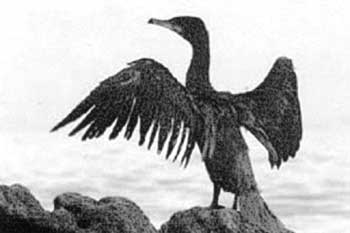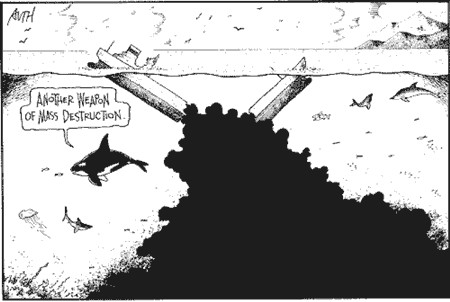![]()
Write us!
[email protected]
Bye Bye Birdie
By Bonnie Weinstein
 |
| An oil-soaked cormorant on the Spanish coast in early December, 2002 |
The sinking of the Prestige oil tanker off the coast of Spain epitomizes how capitalism’s profit driven system is unable to function in the best interest of life on the planet. The story surrounding the rotting hulk of an oil tanker, Prestige, exposes the continued irrational use of single hulled tankers to deliver huge quantities of oil in spite of known dangers and disasters. The entire shipping industry and all the government agencies of the countries involved have been sloughing off responsibility, looking the other way, and legally evading inspections. They have proven to be unable to protect the precious fertile coastal or deep ocean waters of the world. Every authority responsible failed to cause one of the largest oil spills ever—the most recent of thirteen major oil spills since 1967.1
On November 13, 2002, the Prestige ruptured in a violent storm off Cape Finisterre, Spain’s northwestern-most coastline on the Bay of Biscay. A dilapidated, single hulled oil tanker owned by a Greek company, Mare Shipping, operated by Swiss-based Crown Resources, registered in the Bahamas (its flag state—know as a “flag of convenience” because it is a tax haven), and managed by an Athens-based company, Universe Maritime, it had been loaded in St. Petersburg, Russia, and Latvia and was en route to Singapore.
The Prestige was carrying 77,127 metric tons (about 20.5 million gallons) of fuel oil (more toxic than crude oil)—twice the amount carried by the Exxon Valdez when it spilled 38,000 tons of crude oil into Prince William Sound in Alaska in March of 1989. The initial spill of the Prestige amounted to about 800,000 gallons (about 3,000 tons). The final totals have not yet been tallied but reports indicate that the Prestige spilled an additional 11,000 to 22,000 tons of fuel oil before it sank it. That estimate will hold as long as the ship is not still leaking or won’t rupture in the future. It is still thought to hold up to 60,000 metric tons on the bottom of the sea. [See the author’s addendum following this article.]
When the damage to the Prestige became clear and oil began to leak out sometime after or during the storm the French, Spanish and Portuguese governments refused to allow the ship to dock in their ports. The Spanish government then made the controversial decision to tow the vessel away from its shores, which were already being impacted by the initial spill. Four Spanish tugboats towed the vessel out to sea for at least five days and partly into Portuguese waters, leaking oil all the way. It broke in half 130 miles off the Spanish coast and finally sank in waters two miles deep.
In a BBC news article dated November 20, 2002, by Keith Somerville, the chief executive of Smit Salvage, the Dutch company, which tried to save the ship, told the BBC that the ship should not have been moved. “The structural damage was certainly not improved by the five days of towing … we would have been better off in a sheltered area, in which the damage would not have increased and we could have had much easier and rapid control of the vessel,” Hans van Rooy said.
The decision to tow the ship came under attack from the Barcelona newspaper El Periodico on Wednesday: “The decision was taken to tow the boat out to the deep blue yonder, following the well-known practice of cleaners who brush dust under the carpet.… Was the aim to share the risk with Portugal, as if the environment were a national and not a planetary asset?”
Environmental groups that have been studying these disasters have criticized for years the use of single-hulled tankers to transport oil. The Prestige, one of many ageing single-hulled tankers was built quickly and cheaply in Japan in the late 1970’s, is representative of 52% of the more than 10,000 oil tankers currently in operation throughout the world. Referred to as “environmental time bombs” and “floating garbage dumps”, these old-style, single-hulled tankers are in regular use.
An Associated Press article (December 3, 2002) reported, “To prevent similar disasters, the European Union on Tuesday blacklisted 66 ships deemed unsafe, from its ports, and called for a ban on single-hulled vessels—like the Prestige—from transporting heavy fuel oil.” A New York Times article by Emma Daly dated November 27, 2002, reported that, “President Jacques Chirac of France and Prime Minister Jose¢ Mari¢a Aznar of Spain, meeting in Spain at their annual summit gathering, agreed today that beginning on Wednesday, single-hulled tankers more than 15 years old that are carrying oil or tar through waters controlled by each country will be subject to stringent inspections.”
So far the Prestige oil spill has spoiled more than 250 miles of Spanish coastline and is threatening to wash up onto the coastlines of France and Portugal. The Spanish government, accused of deliberately under-reporting the scale of the Prestige spill, has acknowledged that a 12,000-ton slick still menaces the coast of Galicia, where fishing has been banned along a 340-mile stretch of coast. The ban affects about 7,000 people who harvest shellfish or who fish in the area.
On December 1, Reuters reported that in Santiago De Compostela, Spain, “Tens of thousands of angry demonstrators packed Galicia’s capital on Sunday to protest the government’s handling of a tanker disaster as a new wave of fuel oil hit Spanish beaches.… Organizers of the march, held under the slogan ‘Never Again,’ estimated that up to 200,000 people marched through driving rain under a sea of umbrellas. There was no official estimate but one police officer agreed with that figure.”
Driving the protestors’ anger, Reuters continued, was news that, “The fishing village of Muxia on Spain’s northwestern corner, repeatedly cleaned only to be soaked again with thick, foul-smelling fuel oil, was hit again. … For the first time, oil washed up on about 10 beaches near Valdovino, 40 kilometers northeast of La Coruna in northern Galicia, officials said. … The spread of the slick led Galician officials to extend a ban on gathering shellfish—which already covered 400 kilometers of coast—to the bays of Ferrol and Cedeira in northern Galicia. … A larger slick containing most of the estimated 11,000 tons of fuel oil spilled when the Prestige sank … environment Minister Juame Matas said.”
The devastation brought by this spill will be felt for months and years to come along the precious coastline of France, Spain and Portugal. And the presence of a time bomb of oil not yet spilled sitting at the bottom of the sea will weigh heavy on the morale of those who have been cleaning the sludge from the shores and from wildlife. (Every fisherman knows that the clean up is as damaging to the fragile habitat as the spill itself.)
But who will pay for the damage done and yet to come from this spill? While some funds are available from the European Union and the International Oil Pollution Compensation Fund, it is the Spanish, Portuguese, and French fishermen and cannery workers who will be out of work. All the men and women sickened from the stench while frantically scooping up globs from beaches and shorelines, those on the ships that are trying to suck up as much as they can under hazardous conditions, the children living along these shores and who will suffer long-term life-threatening health problems from breathing in these toxic fumes, and all the marine life directly covered by this sludge, are paying the ultimate price.
The captain and officers of the Prestige have been arrested. But the real criminals—the ship owners, managers, insurance agents and oil companies—will remain unpunished. And while some countries are banning these tankers from entering their ports, they remain free to threaten all other ports and the open sea. Plans to replace these ships are long range and extend until the year 2015 in some cases.
Wildlife groups estimate that up to 15,000 birds may have been killed or severely affected. And this disaster may mean the extinction of Spain’s colonies of the guillemot, an endangered species. Eighteen of the birds have been found dead and the total Spanish population of the birds is estimated at only 11 pairs.
While the world’s peoples will bear the brunt of their criminal policy, the shipping and oil company criminals will file for Chapter 11 protection and get bailouts from their governments—or simply continue business as usual.
————————————
1The following list is from a BBC NEWS article dated November 19th, 2002, “Comparing the worst oil spills.”
•January 2000: A ruptured pipeline spewed about 340,000 gallons of heavy oil into Guanabara Bay, Rio de Janeiro in Brazil.
•December 1999: The Erika spilled 13,000 tons of heavy diesel oil off the coast of Brittany.
•February 1996: The Sea Empress spilled about 72,000 tons of crude oil near the port of Milford Haven in Wales.
•January 1993: The Braer grounded off the Shetland Islands spilling 85,000 tons.
•December 1992: A ship called the Aegean Sea spilled 80,000 tons of crude near the port of La Coruna in Spain.
•May 1991: The ABT Summer leaked oil after an explosion off Angola spilling 260,000 tons.
•April 1991: The Haven spilled more than 50,000 tons of oil off Genoa in Italy.
•January 1991: Iraq released about 460 million gallons of crude oil into the Persian Gulf during the Gulf War.
•March 1989: The Exxon Valdez is grounded and spilled 38,000 tons of crude oil into Prince William Sound in Alaska—the worst spill in U.S. history.
•August 1983: Fire broke out on the Castillo de Bellver and its cargo of 252,000 tons of oil burnt.
•1979: The Atlantic Empress spilled 160,000 tons off Tobago.
•1978: Wrecked tanker Amoco Cadiz spilled 220,000 tons off the Brittany coast.
•March 1967: The Torrey Canyon spilled 119,000 tons of crude off the Isles of Scilly in the UK.
“Prestige” Still Leaking
By Bonnie Weinstein
The New York Times of December 10th, 2002 printed an Associated Press story “Sunken Tanker in Spain Leaking Oil Daily.” After spilling at least five million gallons of fuel oil, the Prestige continues to leak about 33,000 gallons of fuel oil every day. An examination by a French research submarine revealed several cracks in the bow and stern of the sunken Prestige. The Deputy Prime Minister of Spain, Mariano Rajoy said that officials were watching a slick measuring 35 miles by 11 miles floating on the water above where the ship went down. “The leaks from the tanker Prestige could continue into 2006, said Emilio Lora Tamayo, who led a scientific commission studying the disaster.

Write us
[email protected]